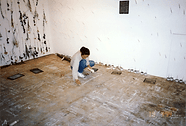HIROSHI KARIYA
BIO 2022 THE NOW IS 寿限無寿限無
A. M. Weaver/1995
Curator, Painted Bride Gallery
The exhibition, Incarnation: Two Perspective,
was designed to coincide with a city-wide project
Prison Sentences: Prison as Site/ Prison as Subject.
The Painted Bride Gallery’s participation in this project offered the opportunity to present socially challenging works that pertain to historically significant events and institutions and philosophical percepts that force the viewer to assess existent life conditions.
Incarceration: Two Perspectives takes a definitive lean towards being a visual expose on Japanese and Japanese American derived experiences in contemporary society.
Hiroshi Kariya’s Installation
No Man Is Free Who Is Not Master Of Himself
is a grand crescendo. His chalk board writings, collages, and wrapped forms are crowded into a prison-like enclosure. (Kariya quote this, is a small scale of our 3D-physically-informed world)
Each item, material and mark alludes to a complex matrix of events, activities, public and private and world conditions.
(No Man Is Free Who Is Not Master Of Himself, Epictetus)
No Man Is Free Who Is Not Master Of Himself
is a continuum of a work created in 1993. Sign of the Times, Kariya’s installations evolve and flow like a river from one piece to another. An integral part of his process is to compile layer upon layer of data, building each project by expanding or editing depending on time and space.
Since 1977 Kariya has been writing “sutras” (repetition of “the now is”: 3 words: 1 phrase writings on the various objects) that are both personal and cathartic. Explored in a plethora of mediums: seeds, shards of masonite, stones and wood these “sutras” exist in constant states of evolution. Information is perpetually recorded and erased-depending on the material-revealing a synopsis of Kariya’s experiences, states of being and commentaries on current events.
Significant to
No Man Is Free Who Is Not Master Of Himself
is the concept of freedom, which is a central theme of the works by the Chinese philosopher Chung Tzu. (…)
Kariya’s construction attempts to engage the viewer by challenging the perception of prison: here the prison is the self, the mind, systems and world conditions. Many of China’s ancient philosophers entertained the issue of how man can live in a world dominated by chaos, suffering and absurdity. Chuang Tzu responds in mystical terms, contrasting concrete and systematic discourses promoted by other thinkers of his time, by staring all is relegated to the constant. “… No thing is either complete or impaired, but all are made into one again. Only the man of far-reaching vision knows how to make them into one. So he has no use [for categories],”1
By translating the essence of what one has to divest oneself of thought process and artifact, Kariya brings clarity to a postmodernist arena utilizing ancient concepts.
Process, treatment of surfaces and marking are integral to Hiroshi Kariya’s work. The front and reverse sides of tablets and chalkboards are marked and/or collaged.
An ardent practitioner of Gichin Funakoshi’s Shotokan style Karate (JKA/WKF Official Japana Karate Association, Instructor Class A licence holder, 6th Dan black belt) which is the importance of background or what is behind. Kariya translates this concept in visual terms focusing on the frontal and reverse sides of surfaces. His wrapped human corpses are discarded materials. Materials from previous works and found objects cannot the relationship between past and present, symbolically representing the continuum of existence. Pertinent to aspects of Kariya’s conceptualizations are Eastern ideologies that relate to contemporary societal conditions and concerns.
A.M. Weaver
No Man Is Free Who Is Not Mater Of Himself, 1995
A.M.ウィーバー/1995
キュレーター、ペインティッドブライド
展覧会、化身:二つの視点
フィラデルフィア市全域プロジェクト合同企画
刑務所/定義:場としての刑務所/課題としての刑務所。
ペインテッドブライドギャラリーに於ける今プロジェクトへの参加は、歴史的に重要な事件や制度に関連する社会的に挑戦的な作品と、視聴者に既存の生活条件の再考を余儀なくさせる哲学的認識を提示する機会を提供いたします。
化身:2つの視点は、現代社会における日系アメリカ人による経験を視覚的に公開することによって観客に決定的な影響をもたらすものと信じます。
刈谷博のインスタレーション「自が己の主でない者は自由に在らず」は壮大なクレッシェンドで強さが増してゆく作品です。黒板の上の記述痕跡やコラージュ、そして梱包された形体は、刑務所の囲いの中に封じ込まれています。
各アイテム、素材、傷跡・痕跡は、イベント、活動、公私および世界の状況の複雑なマトリックス、雛形であることを暗示しています。
「自が己の主でない者は自由にあらず」は、1993年に制作された作品の連続体です。「時刻・時のしるし」と題された、刈谷のインスタレーションは進化し、川の流れのように作品から作品へと連続しつづいていきます。制作のプロセスで不可欠な部分は、記述記録が各層ごとにコンパイルし、時間と空間に応じ拡張または編集作業によって各プロジェクトを構築していくことです。
(コンパイル:プログラミング言語で記述されたソフトウエアの設計図、ソースコードを、コンピューターが実行可能な、オブジェクトコードに変換する作業)
1977年以来、刈谷は個人的でカタルシス的な「お経」または「糸」(「the now is」三つの語:一句の繰り返しをさまざまなオブジェクトに)を記述する行為をしてきました。それは種子、メゾナイトの破片、石、木材など、さまざまな媒体で実験検証しつづけられます。これらの「お経」は常に進化の状態・現在進行形で存在します。情報は永久に記録され、消去されます-資料に応じて-刈谷の経験の概要、存在の状態、現在の出来事についての解説が明らかになって行くという形式です。
中国の哲学者荘子の中心的なテーマである自由の概念は「自が己の主でない者は自由にあらず」にとって重要です。 (…中略…)
作品の構造は、刑務所とは?という課題に挑戦することによって視聴者を引き付けようとします。
ここにおいて、刑務所とは自己、心、システム、そして世界の状況を示します。中国の古代哲学者の多くは、混沌、苦しみ、そして不条理に支配された世界で、人間はどのように生きることができるか、という問題定義を楽しませました。荘子は神秘的な言葉で反応し、彼の時代の他の思想家によって促進された具体的で体系的な言説を対比し、すべてを見つめることによって、定数に追いやられます。
「…完全なものも損なわれたものなどというものはなく、すべてが再び一つになります。それらを一つにする方法を知っているのは、遠大なビジョンを持つ人だけです。したがって、彼は(カテゴリに分類して)役に立たないもの」などないという統合の立場を提示します。思考プロセスとアーティファクトから自分自身を奪う必要があるものの本質を翻訳することによって、刈谷は古代の概念を用いてポストモダニストの分野に明快さをもたらします。
プロセスそのもの、表面に至ること、その途上の痕跡を記録する記述は、刈谷博の作品に不可欠な要素です。そうやって、タブレットや黒板の表と裏には、マークやコラージュが施されるのです。
芸術制作の裏舞台で刈谷は、船越義珍の松濤館空手道(日本空手協会JKA / WKF 6段黒帯の保持者で国際指導員認定A級を所持する)の熱心な熟練者であり、本質は表に見える物にではなく、背景や背後にあるその実践内在を、面に現れない存在性を提示します。刈谷はこのコンセプトを、表面の表側と裏側に焦点を当てた視覚的な用語で翻訳します。彼が提示する包まれた人間の形体の中身は廃棄された材料です。既存の作品や見出された物質など過去と現在の関係を築くことはできない物を結びつけ、存在の系を象徴的に表示します。そのような刈谷のコンセプトの側面に関連するのは、現代の社会情勢と懸念に関わってくる東洋の根本原理の内面性を示唆するのです。
A.M. Weaver
No Man Is Free Who Is Not Mater Of Himself, 1995
BIO 2022 THE NOW IS 寿限無寿限無











